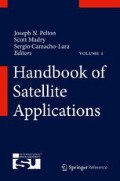Abstract
One of the key elements of a communications satellite service is the ability to launch satellites into precisely defined orbits and to maintain them in the desired orbit throughout the lifetime of the satellite. This systems control and oversight of satellite orbits involves not only the technical ability to launch and maintain the orbit, but also the ability to attain the proper legal authority at the national and international level to transmit and/or receive radio signal from these orbits. This regulatory process means a number of specific steps associated with registering for the allocated frequencies from the International Telecommunication Union through a national governmental administration, obtaining assignments of those frequencies in the required orbits in accord with national licensing procedures, and coordination of the use of the specific frequencies through intersystem coordination procedures.
There are a wide range of different orbits that are currently used in communication satellite services although the most common are geosynchronous Earth orbits (GEO), medium Earth orbits (MEO), and low Earth orbits (LEO). This chapter explains the various orbits that can be used and the advantages and disadvantages of each of the orbits most often employed for satellite communications. This analysis indicates some of the primary “trade-offs” that are used by satellite system engineers in seeking to optimize a satellite systems performance both in its design and subsequently over its operational lifetime. The activities involved in selecting an orbit, designing and achieving an operational satellite network, and optimizing its technical, operational, and financial performance over the systems lifetime involve a wide range of issues. These start with selecting a desired orbital framework, obtaining authorization for orbital access (including the registering and pre-coordination of the satellite and its orbit with other systems), launch, deployment and test, systems operation, and end-of-life disposal of a satellite from its orbit.
Access this chapter
Tax calculation will be finalised at checkout
Purchases are for personal use only
References
C. Charles, F. Ciovanni, F. Lauren, G. James, M. Mikhail, Mc.Kay. Chris, R. Michael, S. Isabelle, The Universe and Us Chapter 5, in The Farthest Shore: A 21st Century Guide to Space, ed. by J. N. Pelton, A. Bukley (Apogee Books, Burlington, 2009), p. 157
J.N. Pelton, Global Communications Satellite Policy: Intelsat, Politics and Functionalism (Lomond Books, Mt. Airy, 1974), p. 48
J.N. Pelton, Research Report: Satellite Communications – The Transition to Mass Consumer Markets, Technologies and Networks (International Engineering Consortium, Chicago, IL, 2001), pp. 228–230
J.N. Pelton, Basics of Satellite Communications (International Engineering Consortium, Chicago, 2006), p. 73
J.N. Pelton, S. Madry, Satellites in Service to Humanity, in The Farthest Shore: A 21st Century Guide to Space, ed. by J.N. Pelton, A. Bukley (Apogee Books, Burlington, 2009), p. 220
M. Williamson, The Communications Satellite (IOP Publishing, Bristol, 1990), pp. 76–83
Author information
Authors and Affiliations
Corresponding author
Editor information
Editors and Affiliations
Rights and permissions
Copyright information
© 2013 Springer Science+Business Media New York
About this entry
Cite this entry
Pelton, J.N. (2013). Satellite Orbits for Communications Satellites. In: Pelton, J.N., Madry, S., Camacho-Lara, S. (eds) Handbook of Satellite Applications. Springer, New York, NY. https://doi.org/10.1007/978-1-4419-7671-0_5
Download citation
DOI: https://doi.org/10.1007/978-1-4419-7671-0_5
Publisher Name: Springer, New York, NY
Print ISBN: 978-1-4419-7670-3
Online ISBN: 978-1-4419-7671-0
eBook Packages: EngineeringReference Module Computer Science and Engineering

